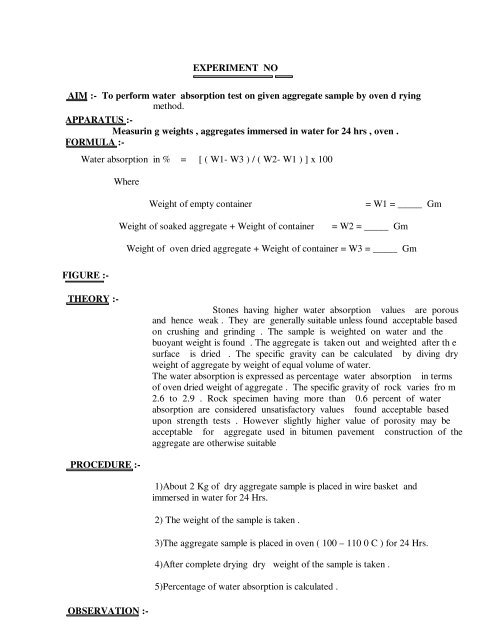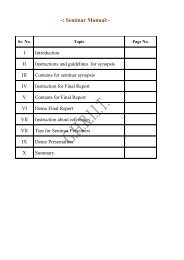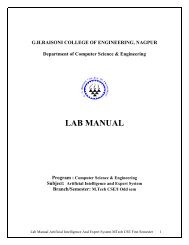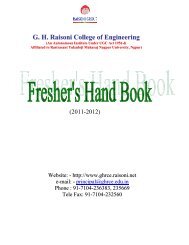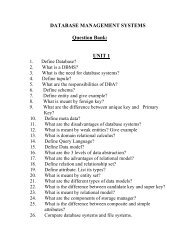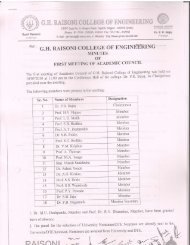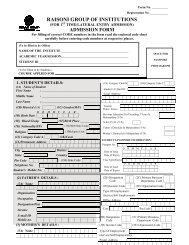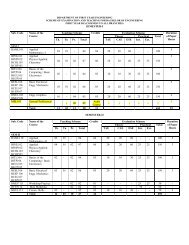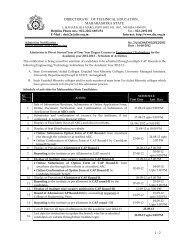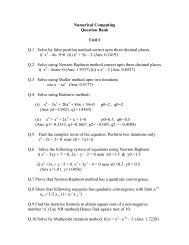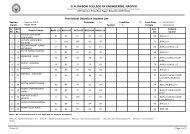EXPERIMENT NO AIM :- To perform water absorption test ... - Raisoni
EXPERIMENT NO AIM :- To perform water absorption test ... - Raisoni
EXPERIMENT NO AIM :- To perform water absorption test ... - Raisoni
You also want an ePaper? Increase the reach of your titles
YUMPU automatically turns print PDFs into web optimized ePapers that Google loves.
<strong>EXPERIMENT</strong> <strong>NO</strong><br />
<strong>AIM</strong> :- <strong>To</strong> <strong>perform</strong> <strong>water</strong> <strong>absorption</strong> <strong>test</strong> on given aggregate sample by oven d rying<br />
method.<br />
APPARATUS :-<br />
Measurin g weights , aggregates immersed in <strong>water</strong> for 24 hrs , oven .<br />
FORMULA :-<br />
Water <strong>absorption</strong> in % = [ ( W1- W3 ) / ( W2- W1 ) ] x 100<br />
FIGURE :-<br />
THEORY :-<br />
Where<br />
PROCEDURE :-<br />
OBSERVATION :-<br />
Weight of empty container = W1 = _____ Gm<br />
Weight of soaked aggregate + Weight of container = W2 = _____ Gm<br />
Weight of oven dried aggregate + Weight of container = W3 = _____ Gm<br />
Stones having higher <strong>water</strong> <strong>absorption</strong> values are porous<br />
and hence weak . They are generally suitable unless found acceptable based<br />
on crushing and grinding . The sample is weighted on <strong>water</strong> and the<br />
buoyant weight is found . The aggregate is taken out and weighted after th e<br />
surface is dried . The specific gravity can be calculated by diving dry<br />
weight of aggregate by weight of equal volume of <strong>water</strong>.<br />
The <strong>water</strong> <strong>absorption</strong> is expressed as percentage <strong>water</strong> <strong>absorption</strong> in terms<br />
of oven dried weight of aggregate . The specific gravity of rock varies fro m<br />
2.6 to 2.9 . Rock specimen having more than 0.6 percent of <strong>water</strong><br />
<strong>absorption</strong> are considered unsatisfactory values found acceptable based<br />
upon strength <strong>test</strong>s . However slightly higher value of porosity may be<br />
acceptable for aggregate used in bitumen pavement construction of the<br />
aggregate are otherwise suitable<br />
1)About 2 Kg of dry aggregate sample is placed in wire basket and<br />
immersed in <strong>water</strong> for 24 Hrs.<br />
2) The weight of the sample is taken .<br />
3)The aggregate sample is placed in oven ( 100 – 110 0 C ) for 24 Hrs.<br />
4)After complete drying dry weight of the sample is taken .<br />
5)Percentage of <strong>water</strong> <strong>absorption</strong> is calculated .
CALCULATION :-<br />
RESULT :-<br />
PRECAUTION :-<br />
DISCUSSION :-<br />
Weight of empty container = W1 = _____ Gm<br />
Weight of soaked aggregate + Weight of container = W2 = _____ Gm<br />
Weight of oven dried aggregate + Weight of container = W3 = _____ Gm<br />
Water <strong>absorption</strong> in % = [ ( W1- W3 ) / ( W2- W1 ) ] x 100<br />
Percentage of <strong>water</strong> <strong>absorption</strong> for a given sample of aggregate is found to<br />
be _________ %.<br />
1) The aggregate must be immersed properly in <strong>water</strong> for 24 Hrs .<br />
2)The <strong>water</strong> from surface of aggregate must be dried .<br />
3)Weight the aggregate carefully in spring balan ce.<br />
Rock specimen having more than 0.6 % <strong>water</strong> <strong>absorption</strong><br />
values are considered unsatisfactory unless found acceptable based on<br />
strength <strong>test</strong> . However slightly higher value of porosity may be acceptable<br />
for aggregate used in bituminous pavement construction if aggregate is<br />
found otherwise suitable.
<strong>AIM</strong> :-<br />
<strong>EXPERIMENT</strong> <strong>NO</strong><br />
<strong>To</strong> determine flakiness index of aggregate .<br />
APPARATUS :-<br />
Aggregate, set of sieves, tray, weight box etc.<br />
FORMULA :-<br />
Where,<br />
w = Weight of aggregate passing<br />
W = Weight of aggregate retained<br />
FIGURE :-<br />
THEORY :-<br />
PROCEDURE :-<br />
flakiness index = [ w / W ] X 100<br />
The principal shape of Aggregate mass is determine by the<br />
percentage of flaky and elon gated particles contained in it and by its<br />
angularity . The evaluation of shape of particles made of flakiness index<br />
and elongated index and angularity numbers .<br />
The flakiness index of aggregate is the per centage by<br />
weight of aggregate particles whose least dimensional thickness is less<br />
than 0.6 times their mean dimension. The <strong>test</strong> is applicable to size larger<br />
than 6.3 mm standard thickness is used to guage the thickness of sample .<br />
1) The sample of aggregate to b e <strong>test</strong>ed is sieved through a set of sieves and<br />
separated into a specified size ranges.<br />
2) Now to separate the flaky material , the aggregate which pass through<br />
the appropriate elongated slot of thickness guage are found .The width of<br />
the appropriate slot would be 0.6 of the average of the sieve size range.<br />
3) The flaky material passing the appropriate slot from each size range of<br />
<strong>test</strong> aggregate are added up and let the weight be W1.<br />
4) If the total weight of sample take from different size range is w, the<br />
flakiness index is given by<br />
Flakiness Index = [ W1 / W ] X 100
OBSERVATION TABLE :-<br />
Sieve Weight Weight of<br />
Sr W<br />
No. Retained Aggregate passing<br />
No<br />
(gm)<br />
(mm) W(Gm) appropriate slot (gm)<br />
1<br />
2<br />
3<br />
4<br />
5<br />
6<br />
CALCULATION :-<br />
RESULT :-<br />
DISCUSSION :-<br />
APPLICATION :-<br />
flakiness index = [ w / W ] X 100<br />
F. I. = [ w / W ]<br />
X 100<br />
The Flakiness Index of a given aggregate sample is found to be _______ %.<br />
Elongated aggregate are less workable , they are also likely to<br />
break under smaller load s than the aggregate which are spherical or cubical<br />
, flakiness index values in excess of 15 % are generally consider<br />
undesirable . If is desirable that flakiness index of aggregate used in road<br />
construction is less than 15 % and normally does not exceed 25 %.<br />
If the flakiness index is more than the aggregate can take less<br />
loads and are liable to fail under less load . So it is not desirable to use<br />
aggregate of higher flakiness index is permanent .
(W2-W1 )<br />
FIGURE :-<br />
(W2-W1 )<br />
<strong>EXPERIMENT</strong> <strong>NO</strong><br />
<strong>AIM</strong>:- <strong>To</strong> determine specific gravity of a given aggregate sample by Pycnometer<br />
Pycnometer balance, Weight –box, aggregate<br />
APPARATUS:-<br />
FORMULA:-<br />
THEORY :-<br />
Specific gravity =<br />
(W2-W1) – (W3-W4)<br />
Where<br />
Weight of empty Pycnometer = W1 gms<br />
Weight of Pycnometer + aggregate = W2 gms<br />
Weight of Pycnometer + aggregate +Water = W3 gms<br />
Weight of Pycnometer + Water = W4 gms<br />
Weight of aggregate = (W2-W1) gm.<br />
Weight of equal volume of distilled <strong>water</strong> = (W2-W1) – (W3-W4) gms<br />
Specific gravity is the ratio of the weight of given volume of<br />
dry aggregate to the weight of equal volume of distilled <strong>water</strong>.<br />
Let (i) Weight of empty Pycnometer = W1 gms<br />
(ii) Weight of Pycnometer + aggregate = W2gms<br />
(iii)Weight of Pycnometer + aggregate +Water = W3 gms<br />
(iv)Weight of Pycnometer + Water = W4 gms<br />
Weight of aggregate = (W2-W1) gm.<br />
Weight of equal volume of distilled <strong>water</strong> = (W2-W1) – (W3-W4) gms<br />
Specific gravity =<br />
(W2-W1) – (W3-W4)
PROCEDURE:-<br />
OBSERVATION TABLE :-<br />
SR<br />
No<br />
1<br />
2<br />
3<br />
4<br />
Weight of<br />
aggregates<br />
(1)Make the Pycnometer dry &Weight it with its cap &rin g<br />
(2)Unscrew the cap &Rut 200 gms of aggregate &Weight it<br />
(3)Add <strong>water</strong> to the top of brass cap. Remove all the trapped dir by pouring<br />
additional <strong>water</strong><br />
(4)Dry the Pycnometer & fell it to the top with & weight it<br />
(5)Repeat the Pro cedure<br />
(6)Find the average specific gravity by using formula<br />
Weight of<br />
empty<br />
pycnometer<br />
(W1)gm<br />
SAMPLE CALCULATION:-<br />
Weight of<br />
pycnometer<br />
+aggregate<br />
(W2) gm<br />
Average specific gravity =<br />
(W2-W1) Specific gravity =<br />
(W2-W1) – (W3-W4)<br />
G =<br />
Weight of<br />
pycnometer<br />
+<strong>water</strong><br />
+aggrate<br />
(W3) gm<br />
RESULT:-<br />
Average specific gravity is found to be ___________<br />
PRECAUTIONS:-<br />
DISCUSSIONS:-<br />
(1) Take the weight carefully.<br />
(2) Pycnometer must be dry for use.<br />
Weight of<br />
Pycnometer<br />
+<strong>water</strong><br />
(W4) gm<br />
(3) There should be no air bubble inside the bottle.<br />
Specific<br />
gravity<br />
The value of specific gravity of aggregate is required for<br />
concrete mix design and useful for calculating <strong>water</strong> content. Stone having<br />
higher <strong>water</strong> <strong>absorption</strong>s values are porous and this weaker specific gravity<br />
also indicates strong specimen.
<strong>EXPERIMENT</strong> <strong>NO</strong><br />
<strong>AIM</strong>: - <strong>To</strong> determine the Flash &Fire point for the sample of bitumen taken.<br />
APPARATUS: -<br />
Flash point set up, thermometer, heating arrangement etc.<br />
FIGURE:-<br />
THEORY: -<br />
This <strong>test</strong> gives up the indications of the critical temperatur e<br />
at which the suitable precautions should be taken while heating bitumen .<br />
Flash Point:-The temperature at which the volatile material i.e. bitumen<br />
emits vapours and it catches fire momentarily in the form of flash.<br />
Fire Point :-The temperature at which the volatile nature i.e. bitumen emits<br />
vapours get ignited and burns<br />
PROCEDURE: -<br />
The material is filled up to the mark of filling in the cup<br />
liquid is placed too dose to the cup .All accessories including thermometers<br />
are fixed .The sample is heated at rate of 50to60 0C/min. The first flash as<br />
applied at <strong>test</strong> 170 C below actual flash point.<br />
The flash point as taken as the temperature reading on the<br />
thermometer at the time of applications of flame that causes bright flash in<br />
the interior of cup. The heating is continuous till the material’s ignited. This<br />
gives the fire point.<br />
RESULT: -<br />
i) Flash Point =<br />
ii) Fire Point =<br />
DISCUSSION:-<br />
The bitumen material leaves out volatile at high temperature<br />
depending up on their grades. These volatile catch fire causing a flash. This<br />
condition is very hazardous.<br />
PRECAUTION: -<br />
APPLICATION: -<br />
If the candle is used as a flame then it should be seen that<br />
flame should not fall in the bitumen, otherwise it would give flame at less<br />
Temperature as wax will catch fir e.<br />
Bitumen is used in construction of pavements so the flash & fire<br />
point is determined to check for the amount of heating to avoid any<br />
accidents.
<strong>EXPERIMENT</strong> <strong>NO</strong><br />
<strong>AIM</strong>:- <strong>To</strong> Determine the impact value of a given a aggregate sample<br />
APPARTAUS:-<br />
FIGURE :-<br />
FORMULA:-<br />
Impact <strong>test</strong>ing machine, aggregates, sieves, weight box, weighing balance<br />
Where,<br />
Impact Value = W3 / (W2 – W1) X100<br />
W1 = empty wt of cylinder.<br />
W2= wt of Cylinder + aggregate.<br />
W3= wt of fines passing through 2.25 mm sieve
THEORY: -<br />
PROCEDURE: -<br />
OBSERVATION:-<br />
CALCULATION:-<br />
RESULT: -<br />
PRECAUTIONS:-<br />
DISCUSSION:-<br />
A <strong>test</strong> designed for to evaluate the toughness of stone or the<br />
resistance of aggregate to fracture under repeated impact is called impact<br />
<strong>test</strong>. The aggregate impact value indicates relative measur es of resistance of<br />
aggregate to impact, which has different effect then the resistance to<br />
gradually incr easing compression stress. The aggregate impact <strong>test</strong>ing<br />
machine consists of a metal case and a cylindrical cap of internal dia of 10.2<br />
cm and a depth of 5 cm in which the aggregate specimen is placed A<br />
hammer of weight 13.5 to 14 kg having a free fall from height 38 cm is<br />
arran ged to drop through a vertical height.<br />
(1)Aggregate specimen passing throu gh 12mm sieve retained on 10mm<br />
sieve is filled in the cylinder in 3 layers by tampin g each other or each layer<br />
by 25 flows and then measures it.<br />
(2)The sample is transferred from balance to cap of the aggregate impact-<br />
<strong>test</strong>ing machin e. The metal hammer is raised to a height of 38cm.Above th e<br />
upper surface of the aggregate in the cap and is allowed to fall freely on the<br />
cap specimen After subjected to15blows of metal hammer, the crashed<br />
aggregate is sieved from 2.36 mm sieve and the sieved weight is noted.<br />
(1)Weight of empty mould = W1 =<br />
(2)Weight of mould + aggregate = W2 =<br />
(3)Weight of tines passing through = W3 =<br />
Impact Value = W3 / (W2 – W1) X100<br />
The impact value of given sample of aggregate found out to be<br />
__________.<br />
(1)The aggregate used should be of good quality.<br />
(2)Hammer should be p roperly handed otherwise it may cause physical<br />
damage or injury.<br />
The impact value indicates the relative measurement of<br />
resistance of aggregate to impact, which has a different effect then th e<br />
r istance to gr adually increased compressive stress. The value less then 10<br />
% to 20 % is satisfactory for wads. The aggregates should not have impact<br />
value more then 30 % & if it is used to say to be weaker for base course the<br />
value should not exceed 40%
<strong>EXPERIMENT</strong> <strong>NO</strong><br />
<strong>AIM</strong>:- <strong>To</strong> Determine California Bearing ratio [CBR] value and sub grade thickness<br />
for compacted soil under given traffic load.<br />
APPARTAUS:-<br />
FIGURE :-<br />
CBR apparatus consisting of mould of 150mm dia with a base plate and a<br />
collar, a 50mm dia, gauge for measuring expansion soaking and penetration
THEORY :-<br />
Hence<br />
WORKING :-<br />
PROCEDURE :-<br />
This method was originally devised by O. J. Parter, then the<br />
California State Highway, by other authority in USA, notably the US<br />
Corporation Of Engineering. The method combines a load penetration <strong>test</strong><br />
<strong>perform</strong> in a lab. This is probably the most widely used method for the<br />
design of flexible pavement.<br />
The thickness of various elements comprising a p avement is<br />
determine by CBR values. It is a small scale p enetration <strong>test</strong> in which a<br />
cylindrical plunger 5 mm dia. is pen etrated into a soil mass. The<br />
observation are taken between the penetr ation resistance into a soil mass at<br />
the ratio of 0.05 inch / min [1.25 mm / min ]. The observations are tak en<br />
between the penetration resistance verses the penetration of plunger. The<br />
California Bearin g Ratio is defined as the ratio of <strong>test</strong> load to the standard<br />
load expressed in percentage<br />
CBR = [Test Load / Standard load ] x 100<br />
The CBR <strong>test</strong> is carried on a compacted soil in a CBR 150<br />
mm dia. and 175 mm height provided with a detachable collar of 50 mm<br />
deep to be kept in the mould during the sp ecimen penetration which<br />
enables a specimen of 1 25 mm deep to be obtained .<br />
The moulding dry density and <strong>water</strong> content should be same<br />
as it should be maintained during field compaction. <strong>To</strong> estimate th e worst<br />
moisture condition of the field, the specimen is submerged in <strong>water</strong> for<br />
about 4 days before <strong>test</strong>ing. Generally CBR value for both soaked and<br />
unsoaked sample and determined both during soaking and penetration the<br />
specimen is carried with equal surcharge weights to estimate the effect of<br />
overlying parameters or particular layer under construction . Each<br />
surcharge weight 147 mm dia with a general hoe of 153 mm in did and<br />
weighing 2.5 kg is considered approximately equivalent to 6.5 cm of<br />
construction . A minimum of two weights are placed as sp ecimen load is<br />
applied on the penetration piston to obtained the penetration of 1.25 mm /<br />
min . The max imum load and penetration is recorded if it occurs for<br />
penetration less than 7 mm.<br />
The soil sample approximately 2000 gm is weighted and<br />
transformed in a tray . About 7 % of <strong>water</strong> of total weight of soil sample is<br />
added in the soil and mix it properly This moisturized sample is compacted<br />
in the CBR in different layers . Each layer is compacted by giving 56 no of<br />
blows by tamp ering rod . After compaction the mould is placed under CBR<br />
<strong>test</strong>ing machine and adjusted properly . The load is applied gradually by<br />
this pressure <strong>test</strong>ing machine and various sets of r eadin g are taken until soil<br />
specimen fails.
OBSERVATIONS:-<br />
(i) Weight of rammer =<br />
(ii) Drop of rammer =<br />
(iii) No. Of layers computed =<br />
(iv) Blows per layers =<br />
(v) Wt. of empty mould =<br />
(vi)Wt. of mould + compacted soil =<br />
(vii) Volume of mould =<br />
(viii)Water content of soil =<br />
(by oven dried method)<br />
(ix) Wt. of empty tray =<br />
Plunger Dia =<br />
Surcharge Wt. =<br />
Test end of specimen = 1 div =<br />
Proving ring constant = 1 div =<br />
PENETRTIO PROVING PROVING LOAD<br />
N<br />
PLU NG ON E STANDARD<br />
LOAD R CBR =<br />
RING RING<br />
(KG) (KG )<br />
TEST LOAD<br />
CONSTANT READING<br />
X 100<br />
STD. LOAD<br />
CALCULATION:-<br />
(1) For penetration 2.5 mm (corrected) CBR<br />
= X 100 =<br />
1376<br />
(2) For penetration 5mm (corrected) % CBR<br />
= X 100 =<br />
2055<br />
CORREC CORREC<br />
TED TEST TED CBR<br />
LOAD VALUR
The sub grade thickness is given by<br />
1.75P A<br />
t = -<br />
CBR 9<br />
Where t = Sub grade thickness<br />
RESULT:-<br />
APPLICATION :-<br />
CBR = CBR Value<br />
P = Wheel Load = 4500 kn<br />
A = Area of sub grade contact<br />
P<br />
A = p = 6.5kg/cm2<br />
p<br />
(1) The CBR value for 2. 5mm penetration is found to be = _______<br />
(2) The CBR value for 5 mm penetration is found to be = ________<br />
This <strong>test</strong> is meant for soils and also carried out on the sub<br />
base and granular base coarse material . The CBR Test values are made use<br />
if an imperial method of flexible pavement design<br />
Grade of load Depth of construction on Traffic density No. of commercial<br />
in cm<br />
vehicle per day exceeding 3 + loaded<br />
wt.<br />
A 31 0 - 15<br />
B 38 15 - 45<br />
C 44 45 - 150<br />
D 50 150 - 450<br />
E 56 450 - 1500<br />
F 64 1500 - 4500<br />
G 70 Above 4500
<strong>EXPERIMENT</strong> <strong>NO</strong><br />
<strong>AIM</strong>: - <strong>To</strong> <strong>perform</strong> penetration <strong>test</strong> on the given sample of bitumen<br />
APPARATUS :-<br />
FIGURE :-<br />
THEORY :-<br />
PROCEDURE :-<br />
OBSERVATION TABLE :-<br />
Penetrometer is penetration <strong>test</strong> apparatus<br />
The penetration <strong>test</strong> determines the hardness and so ftness<br />
of bitumen by measuring the depth of needle in mm to which a standard<br />
loaded needle penetrates vertically 5 sec . The sample is maintained at 250<br />
C.<br />
A bitumen sample of depth about 15mm. is taken into a<br />
container . The sample is arranged on the instrument that the standard<br />
needle just touches the surface of the bitumen sample . The dial is set to<br />
zero . Now initial reading is taken and the needle is released for 5 sec. and<br />
the final reading is taken on the dial gauge . Three reading should be tak en.<br />
Each <strong>test</strong> should be <strong>perform</strong>ed for at least 10 min apart from each other and<br />
the mean value is taken .<br />
Sr Initial Reading Final Reading Differ ence Penetration<br />
No. 1/10 mm 1/10 mm 1/10 mm Value<br />
1<br />
2<br />
3<br />
4<br />
5<br />
Average<br />
Penetration<br />
Value
RESULT :-<br />
PRECAUTION :-<br />
The average penetration of the given sample (bitumen ) is<br />
found to be _____________ mm.<br />
1)The needle should be cleared properly before taking nex t reading .<br />
2)The needle should just touch the bitumen.<br />
3)Minimum 10 min should be maintained between the reading .<br />
APPLICATION :-<br />
It is the most adopted <strong>test</strong> for bitumen depending on climate<br />
condition , type of construction Various bitumen used in permanent constant range<br />
between 20 to 25 .
FIGURE :-<br />
<strong>EXPERIMENT</strong> <strong>NO</strong><br />
<strong>AIM</strong> :-<br />
<strong>To</strong> determine the crushing value of aggregate by aggregate crushed <strong>test</strong><br />
APPARATUS :-<br />
FORMULA :-<br />
Steel cylinder of 152 cm diameter with a base plate and and plunger<br />
compression <strong>test</strong>ing machine , sieves , aggregate etc.<br />
% Crushing Value = [W3 / (W2 – W1 )] x 100<br />
Where<br />
W1 = Weight of empty mould = __________ Kg<br />
W2 = Weight of mould + Aggregate = __________ Kg<br />
W3 = Weight of pan + crushed aggregate = ___________ Kg
THEORY :-<br />
PROCEDURE :-<br />
OBSERVATION :-<br />
CALCULATION :-<br />
RESULT :-<br />
PRECAUTION :-<br />
APPLICATION :-<br />
The strength of coarse aggregate may be determine by<br />
aggregate crushing strength <strong>test</strong> . The aggregate crushing value provides a<br />
relative measure resistance to the crushing order .Gradually applied<br />
compression load , to achieve a high resistance to crushing or low aggregate<br />
crushing value are <strong>perform</strong>ed .<br />
Dry aggregate passin g through 12.5 mm sieve and retained<br />
on 10 mm sieve is filled in the cylinder in three layers . Each layer being<br />
compacted b y 25 blows of tamping rod of diameter 16 mm.Then the<br />
plunger is placed on the top of the specimen and a load of 40 ton es/ min is<br />
applied b y the compression machine .The crushed aggregate are removed<br />
and sieved in 2.35 mm sieve . The material which passes through this sieve<br />
is weighed (Ws ). The value of aggregate is in percentage o f crushing<br />
material passing through 2.35 mm sieve in term of original weight of<br />
specimen .<br />
W1 = Weight of empty mould = ___________Kg<br />
W2 = Weight of mould + Aggregate = __________ Kg<br />
W3 = Weight of pan + crushed aggregate = ___________Kg<br />
% Crushing Value = [W3 / (W2 – W1 )] x 100<br />
The crushing value of the given aggregate is found to be ___________ %<br />
1)Length of the three layers should be approximately equal .<br />
2)Aggregate should be perfectly dry .<br />
3)Mould should be perfectly dry and clean .<br />
4)Sieving should be done carefully.<br />
Stone aggregate gives low crushing value . The crushing<br />
value of good quality aggregate to be used in base coarse should not ex ceed<br />
45 % and the value for the surface co arse should not be less than 30 %.
<strong>EXPERIMENT</strong> <strong>NO</strong><br />
<strong>AIM</strong> :- <strong>To</strong> determine ab rasion value of coarse aggregate by Los Angelis Abrasion<br />
Testing Machine.<br />
APPARATUS :-<br />
FIGURE :-<br />
THEORY :-<br />
PROCEDURE :-<br />
Los Angelis Abrasion Testing Machine , aggregate , cast iron , spear , 17<br />
mm sieve<br />
The principle of Los Angelis Abrasion Test is to find out<br />
percentage valu e due to the relative rubbing action between the aggregate<br />
and the steel ball which are used as an ab rasion char ge .<br />
The <strong>test</strong> procedure co nsists of a rotating drum . It is rotated<br />
at a speed of 20 – 30 rpm . In this cylinder the sample along with the balls<br />
is added . The total weight of sample depends upon the size of aggregate<br />
and number of steel balls and weight of each steel balls . Maximum weight<br />
of steel ball is limited to 5 Kg . The sample and the steel ball are rotated<br />
upto 500 revolution . After completion of revolution , the sample is taken
OBSERVATION TABLE :-<br />
out . It is allowed to pass through 1.7 mm sieve size . The percentage<br />
weight passing is called abrasion value of aggregate.<br />
Weight of aggregate = _________ gm (W1 )<br />
Sr Sieve Size<br />
No (mm)<br />
1<br />
2<br />
3<br />
4<br />
5<br />
6<br />
7<br />
Weight<br />
Retained<br />
W(gm)<br />
Cumulative<br />
Weight retained<br />
(gm)<br />
%Cumulative<br />
Weight<br />
% Finess<br />
CALCULATION :-<br />
RESULT :-<br />
PRECAUTION :-<br />
APPLICATION :-<br />
Weight of sample passing through 1.7 mm Sieve (W2 ) = _________ gm<br />
Abrasion value of a given aggregate sample =<br />
Abrasion value is found to be _________ % of given<br />
aggregate sample by Los Angelis Abrasion Testing Machine.<br />
1) Aggregate should be taken by specific size because number and weight<br />
of steel balls depends upon size of aggregate .<br />
2) Revolution of rotating drum should be rotated and noted perfectly.<br />
Abrasion are carried out to <strong>test</strong> the hardness properly of<br />
coarse aggregate and d ecide wheth er they are suitable for different road<br />
construction work.<br />
The Los Angelis Abrasion value of good quality accepted for cemen t<br />
concrete , bituminous concrete or other high quality bituminous material<br />
should be less than 30% . Here percentage of fines or abrasion value is 10<br />
% , which is less than 30 % and hence given specimen is accepted .<br />
This <strong>test</strong> is carried out to <strong>test</strong> the hardness properly of<br />
coarse aggregate and to decide whether they are suitable for road<br />
construction work The <strong>test</strong> is the best to found out the hardness of<br />
aggregate
<strong>EXPERIMENT</strong> <strong>NO</strong><br />
<strong>AIM</strong> :-<br />
<strong>To</strong> determine the softening point for the given sample of bitumen<br />
APPARATUS :-<br />
Softening point <strong>test</strong> set up .<br />
FIGURE :-<br />
THEORY :-<br />
PROCEDURE :-<br />
The softening point of any substance is the temperature at<br />
which the substance attain a particular degree of softening under specified<br />
condition of <strong>test</strong> . The softening point of bitumen is generally found o ut<br />
by using ring and ball apparatus.<br />
A brass ring containing <strong>test</strong> sample of bitumen is suspended<br />
in liquid like <strong>water</strong> . Some times glycerin can be taken at a given bitumen<br />
sample and set up is placed in liquid . The liquid is heated after due coarse<br />
of time the steel ball fall down because the bitumen is very soft . Th e<br />
temperature at which the ball falls is called as softenin g point . Hard<br />
bitumen softens at high temperature.
OBSERVATION TABLE :-<br />
Ball No. Temperature at which b all falls<br />
CALCULATION :-<br />
RESULT :-<br />
PRECAUTION :-<br />
DISCUSSION :-<br />
APPLICATION :-<br />
Softening Point =<br />
The softening point of given of bitumen sample is found to be ______ 0C .<br />
1)The rate of increase of temperature should be uniform .<br />
2)The stirrer should be used.<br />
Temperature at which the substance attends a particular<br />
degree of softening , This temperature must be kept in mind by the engineer<br />
while construction works. Hard grade bitumen posses higher softening than<br />
soft grade bitumen . Therefore the grade of bitumen can be determine by the<br />
<strong>test</strong> .<br />
The softening point of bitumen is found to check whether is<br />
above the highest surface temperature ,else the bitumen may get slippery .<br />
In slippery the bitumen may even slide down if the softening point is less .


